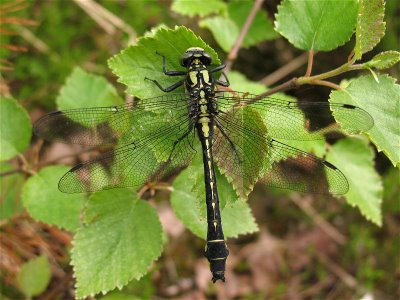The Dragonfly Family
![]()

Adult dragonflies are beneficial bugs because the eat pesty flying insects, particularly midges and mosquitoes. They also will eat butterflies, moths and smaller dragonflies. There is one Asian dragonfly that eats spiders from their webs!
The larvae (or Nymphs), which live in water, eat almost anything living that is smaller than themselves. The larger dragonfly larvae are even known to catch and eat small fish. Usually they eat bloodworms or other aquatic insect larvae. Dragonfly nymphs are such good hunters because they move really fast - by what looks like jet propulsion.
One of the benefits of having dragonflies live nearby is that they eat many times their weight in mosquitoes every day. Dragonflies also eat many different kinds of flies. Using a basket-like arrangement of their legs, adult dragonflies can actually catch and eat other bugs while they are flying.
Dragonflies are large and heavy-bodied insects. They usually hold their wings open and flat when when they are perched on something, just like the dragonfly in the picture above. Their eyes are close together, often touching.
Dragonflies come in many sizes. The average size of a dragonfly is from 1 to 4 inches in length. In prehistoric times dragonflies were much larger - the largest flying insects ever. The largest member of extinct dragonflies had a wing span of about 70-75 cm or about 30 inches.
Although mostly found near ponds and streams, dragonflies are very skilled fliers and can fly many miles from where they live near the water. Because they are such strong fliers; a few kinds of dragonflies even migrate.
Most dragonflies live for about 6 months. At the beginning of their life cycle they are eggs, then they live as larvae or nymphs, and they finally develop into adults. Though most dragonflies don't live too long, there are some larger dragonflies that live for 6 or 7 years! Most of this time is spent living as a larva or nymph, beneath the surface of water, catching other insects.
Dragonflies have some enemies. Birds catch and eat adult dragonflies. Spiders eat dragonflies by catching them in webs. Frogs eat them, and larger species of dragonflies eat the smaller ones. Dragonflies do have ways that can protect themselves from predators. They have excellent eyesight which can help them to evade capture, and they can fly away from their enemies very quickly. Some dragonflies are colored black and yellow, or black and red - these colors are a strong warning to predators that these bugs could be poisonous. The colors actually scare away some of their bird predators. The nymphs or larvae that live underwater are eaten by fish, frogs, toads and newts, and other water invertebrates. They can protect themselves from begin captured by swimming very fast (remember - they have jet propulsion)
Dragonflies do not bite or sting. I you hold a very large dragonflies in the hand, it will sometimes try to bite, they cannot break the skin. Not even the largest dragonflies can actually bite people.
Several species of dragonfly are known to collect in large swarms. In most cases this happens because there is a lot of food in the area. It may also be a "courting" group with males actively searching for females. Some dragonflies gather in swarms before moving to a new area (like a bird migration). The reasons for this are unclear but dragonflies probably migrate when there are too many dragonflies living in one area. There are many records of migratory swarms of dragonflies in the United States.
_____________________________________________________________
COMMON SKIMMER DRAGONFLIES ("Skimmers)
"Skimmers" are beneficial dragonflies. They are beneficial because the adults feed on mosquitoes, midges, flies and winged ants. Nymphs feed on insects that live in the water.
Adults skimmer dragonflies come in a variety of colors as you can see from the pictures below.
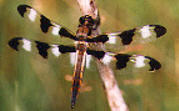
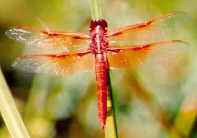
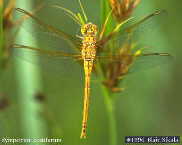
Skimmers are the most common kind of the dragonfly families. The males are the most colorful. Their colors are bright and some have wings with fancy patterns on them (like the black and white skimmer in the picture above). The bodies of skimmers are shorter than than their wingspans. The females are often different colored than males. Females are usually more brown or their color is less bright than males - but the females have similar markings.
Skimmers
live in still water like ponds and small lakes. Most of them sit quietly on the
water, then fly out to
capture their prey. Skimmers glide while flying.
DARNER DRAGONFLIES (Darners)
Darners can usually be seen patrolling and catching other insects near waterways and over fields. Some darner dragonflies swarm like bees when they are hunting and the food is very plentiful.
Darners are large, fast flying dragonflies that come in colors ranging from brilliant blues and greens, to browns with clear wings. Females can be green or brown or purple. They are some of the largest dragonflies and can be up to 3 inches long with a wing span of 3.1 inches. They live near lakes, creeks, and rivers. Some varieties can also live in fields.
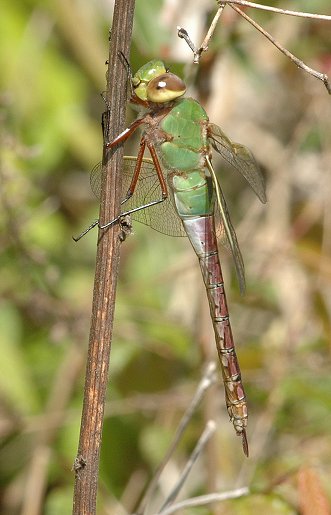 |
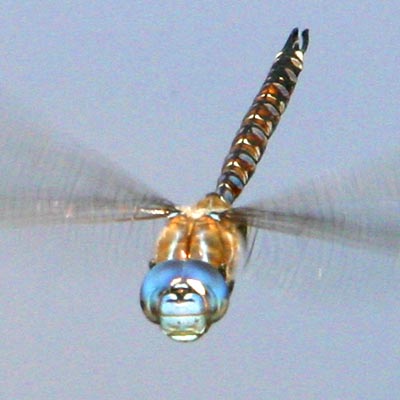 |
|
| Common Green Darner | Blue Eyed Darner |
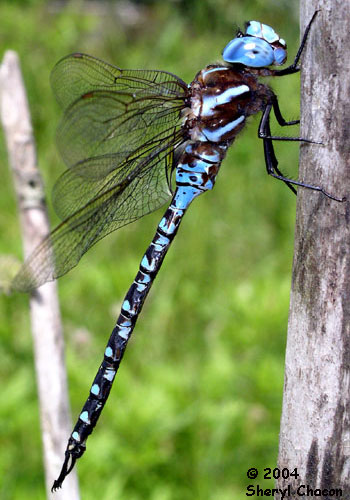
Blue Darner
CLUBTAIL DRAGONFLIES
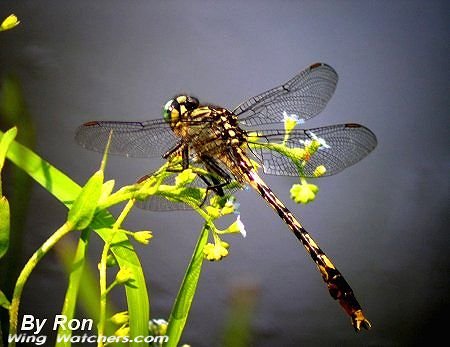
Like other kinds of dragonflies, Clubtails are beneficial bugs because they prey
on other insects like mosquitoes and moths.
There are lots of different kinds of Clubtail Dragonflies. You can recognize a Clubtail because the end of their abdomen (it looks like the end of a tail) is swollen - or fatter than the rest of their abdomen. They also have widely separated eyes. Most other kinds of dragonflies have eyes that touch each other. Clubtails are quite large (from 1.6 to 1.8 inches or 44 to 49 mm in length) when they are adults.
Clubtail dragonflies come in many colors. They can be black, brown, or green and have yellow patterned clear wings. These insects are hard to find because they are so well camouflaged. The females look much like the males but are often yellow where the males are green. Clubtails live near rivers and streams. Males perch on the ground or on rocks. Males can sometimes be found on the beach in sunlit areas. Females are more often found perching on vegetation.
